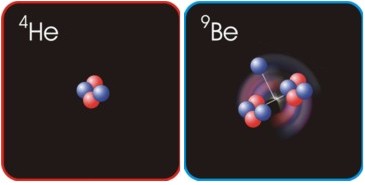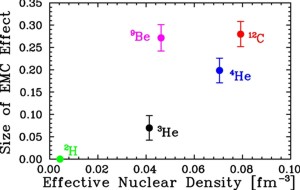Physics Division Research Highlights
EMC Effect in Light Nuclei
 Electron scattering from nuclei shows a clear difference between the quark distributions in heavy and light nuclei, a phenomenon called the “EMC effect”. A detailed understanding has been elusive, and even some basic questions have been difficult to answer: does the effect depend on the mass or density of the nucleus, and does this difference in the quark structure of nuclei imply a modification of the intrinsic quark sub-structure of the protons and neutrons themselves?
Electron scattering from nuclei shows a clear difference between the quark distributions in heavy and light nuclei, a phenomenon called the “EMC effect”. A detailed understanding has been elusive, and even some basic questions have been difficult to answer: does the effect depend on the mass or density of the nucleus, and does this difference in the quark structure of nuclei imply a modification of the intrinsic quark sub-structure of the protons and neutrons themselves?
JLab experiment E03-103, led by the Argonne Medium Energy Physics group, provided a precise measurement of the EMC effect in four light nuclei: 3He, 4He, 9Be, and 12C. Two nuclei (3He and 4He) are very light, while two (3He and 9Be) have very low densities, allowing us to test the density-dependent and mass-dependent models. The data showed that both of these models fail to describe the light nuclei: The effect in 4He is too large for the mass-dependent explanations, while the effect in 9Be is too large for the density-dependent models.
 The unusual structure of 9Be, essentially two orbiting alpha-like clusters with an additional neutron, suggests an explanation for this unexpected behavior. The orbiting clusters yield a large radius and an anomalously low average density, even though most nucleons are contained within the high local densities of the alpha clusters. This suggests that it may be the local environment of the nucleons that determines the extent to which the quark structure is modified, demonstrating the importance of clustering effects in nuclei and providing the first evidence that the local density determines the impact of the nuclear environment.
The unusual structure of 9Be, essentially two orbiting alpha-like clusters with an additional neutron, suggests an explanation for this unexpected behavior. The orbiting clusters yield a large radius and an anomalously low average density, even though most nucleons are contained within the high local densities of the alpha clusters. This suggests that it may be the local environment of the nucleons that determines the extent to which the quark structure is modified, demonstrating the importance of clustering effects in nuclei and providing the first evidence that the local density determines the impact of the nuclear environment.
![[Argonne Logo]](/images/argonne_header_logo.jpg)
![[DOE Logo]](/images/header_doe.gif)